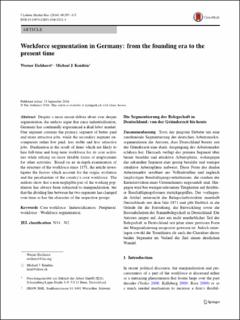Please use this identifier to cite or link to this item:
https://doi.org/10.21256/zhaw-3161| Publication type: | Article in scientific journal |
| Type of review: | Peer review (publication) |
| Title: | Workforce segmentation in Germany : from the founding era to the present time |
| Authors: | Eichhorst, Werner Kendzia, Michael Jan |
| et. al: | No |
| DOI: | 10.21256/zhaw-3161 10.1007/s12651-016-0211-3 |
| Published in: | Journal for Labour Market Research |
| Volume(Issue): | 49 |
| Issue: | 64 |
| Page(s): | 297 |
| Pages to: | 315 |
| Issue Date: | 23-Sep-2016 |
| Publisher / Ed. Institution: | SpringerOpen |
| ISSN: | 2510-5027 |
| Language: | English |
| Subjects: | Core workforce; Industrialisation; Peripheral workforce; Workforce segmentation |
| Subject (DDC): | 331: Labor economics |
| Abstract: | Despite a more recent debate about ever deeper segmentation, the authors argue that since industrialization, Germany has continually experienced a dual labor market. One segment contains the primary segment of better paid and more attractive jobs, while the secondary segment encompasses rather low paid, less stable and less attractive jobs. Dualization is the result of firms which are likely to hire full-time and long-term workforce for its core activities while relying on more flexible forms of employment for other activities. Based on an in-depth examination of the structure of the workforce since 1871, the article investigates the factors which account for the origin, evolution and the peculiarities of the country’s core workforce. The authors show that a non-negligible part of the working population has always been subjected to marginalization, but that the dividing line between the two segments has changed over time as has the character of the respective groups. |
| URI: | https://digitalcollection.zhaw.ch/handle/11475/17627 |
| Fulltext version: | Published version |
| License (according to publishing contract): | CC BY 4.0: Attribution 4.0 International |
| Departement: | School of Management and Law |
| Organisational Unit: | International Management Institute (IMI) |
| Appears in collections: | Publikationen School of Management and Law |
Files in This Item:
| File | Description | Size | Format | |
|---|---|---|---|---|
| 20160923_Kendzia_Workforce segmentation in Germany.pdf | 925.22 kB | Adobe PDF |  View/Open |
Show full item record
Eichhorst, W., & Kendzia, M. J. (2016). Workforce segmentation in Germany : from the founding era to the present time. Journal for Labour Market Research, 49(64), 297–315. https://doi.org/10.21256/zhaw-3161
Eichhorst, W. and Kendzia, M.J. (2016) ‘Workforce segmentation in Germany : from the founding era to the present time’, Journal for Labour Market Research, 49(64), pp. 297–315. Available at: https://doi.org/10.21256/zhaw-3161.
W. Eichhorst and M. J. Kendzia, “Workforce segmentation in Germany : from the founding era to the present time,” Journal for Labour Market Research, vol. 49, no. 64, pp. 297–315, Sep. 2016, doi: 10.21256/zhaw-3161.
EICHHORST, Werner und Michael Jan KENDZIA, 2016. Workforce segmentation in Germany : from the founding era to the present time. Journal for Labour Market Research. 23 September 2016. Bd. 49, Nr. 64, S. 297–315. DOI 10.21256/zhaw-3161
Eichhorst, Werner, and Michael Jan Kendzia. 2016. “Workforce Segmentation in Germany : From the Founding Era to the Present Time.” Journal for Labour Market Research 49 (64): 297–315. https://doi.org/10.21256/zhaw-3161.
Eichhorst, Werner, and Michael Jan Kendzia. “Workforce Segmentation in Germany : From the Founding Era to the Present Time.” Journal for Labour Market Research, vol. 49, no. 64, Sept. 2016, pp. 297–315, https://doi.org/10.21256/zhaw-3161.
Items in DSpace are protected by copyright, with all rights reserved, unless otherwise indicated.